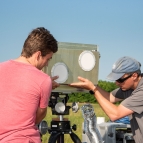Dual-Use Waveforms for Radar Detection and Wireless Communication

Radar and wireless communications systems typically operate in different radio-frequency (RF) bands to avoid cross-interference. However, today’s abundance of wireless devices is crowding the RF spectrum. To free up space in the spectrum, researchers are exploring ways for these devices to share the same RF bands.
A Lincoln Laboratory team developed a technology to enable such band sharing: Constrained Communications and Radar Dual-Use (CONCORD). CONCORD is a method of designing waveforms that can simultaneously perform radar and communications functions with the same transmitter and receiver. Unifying the hardware used for these functions simplifies system design and could ultimately reduce system cost, weight, and power consumption. With CONCORD, system designers can develop an “alphabet” of waveforms that fulfills desired performance goals for a radar system and can be used to code data into a communications data stream. The communications alphabet can be designed such that data are transmitted and received close to the theoretical upper limit for data communications (as defined by the specified radar performance constraints).
The Laboratory team field tested this technology using a flexible in-house test bed. They achieved excellent communications and radar performance with a proof-of-concept setup in which raw data are recorded and subsequently post-processed. The waveform algorithms can be realized in real time using today’s computational hardware. CONCORD, which received a 2022 R&D 100 Award, has application for any system that needs to sense objects with radar and send out data, such as airborne imaging and autonomous driving systems.
For more information on CONCORD, refer to the Innovation Highlight.



